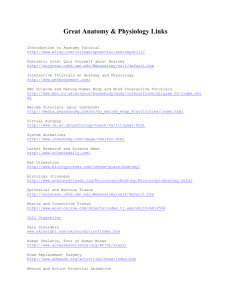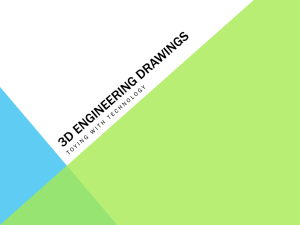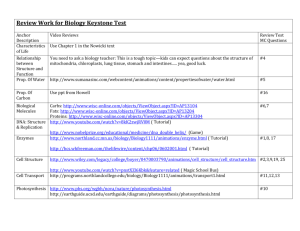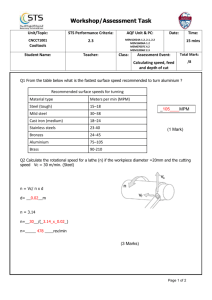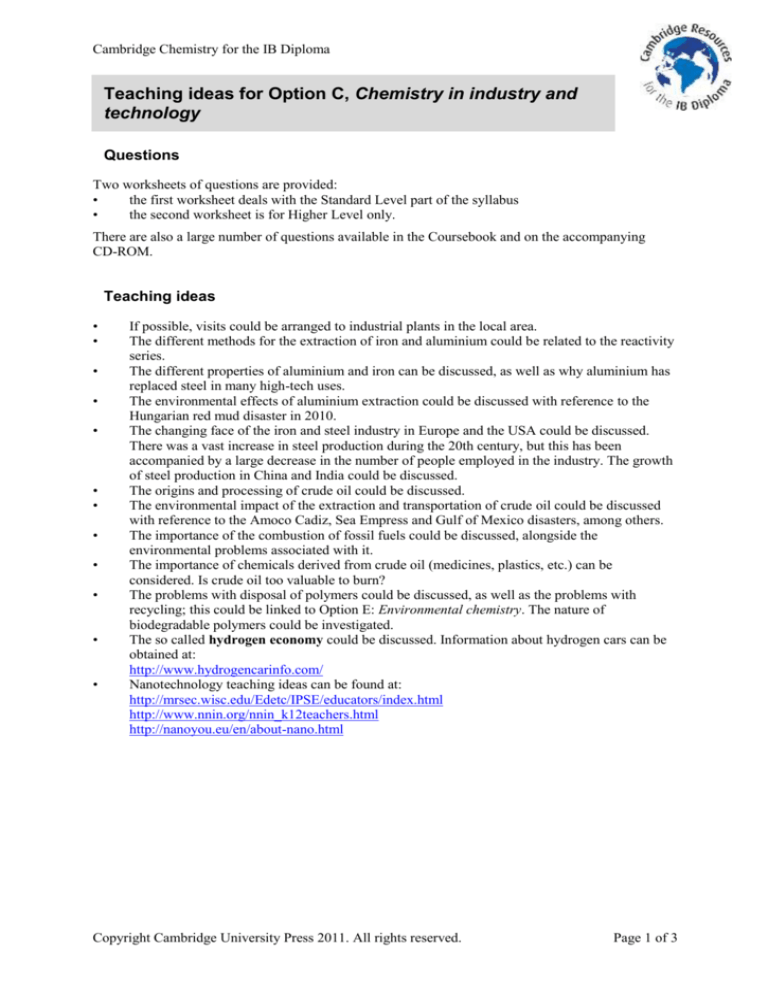
Cambridge Chemistry for the IB Diploma
Teaching ideas for Option C, Chemistry in industry and
technology
Questions
Two worksheets of questions are provided:
•
the first worksheet deals with the Standard Level part of the syllabus
•
the second worksheet is for Higher Level only.
There are also a large number of questions available in the Coursebook and on the accompanying
CD-ROM.
Teaching ideas
•
•
•
•
•
•
•
•
•
•
•
•
If possible, visits could be arranged to industrial plants in the local area.
The different methods for the extraction of iron and aluminium could be related to the reactivity
series.
The different properties of aluminium and iron can be discussed, as well as why aluminium has
replaced steel in many high-tech uses.
The environmental effects of aluminium extraction could be discussed with reference to the
Hungarian red mud disaster in 2010.
The changing face of the iron and steel industry in Europe and the USA could be discussed.
There was a vast increase in steel production during the 20th century, but this has been
accompanied by a large decrease in the number of people employed in the industry. The growth
of steel production in China and India could be discussed.
The origins and processing of crude oil could be discussed.
The environmental impact of the extraction and transportation of crude oil could be discussed
with reference to the Amoco Cadiz, Sea Empress and Gulf of Mexico disasters, among others.
The importance of the combustion of fossil fuels could be discussed, alongside the
environmental problems associated with it.
The importance of chemicals derived from crude oil (medicines, plastics, etc.) can be
considered. Is crude oil too valuable to burn?
The problems with disposal of polymers could be discussed, as well as the problems with
recycling; this could be linked to Option E: Environmental chemistry. The nature of
biodegradable polymers could be investigated.
The so called hydrogen economy could be discussed. Information about hydrogen cars can be
obtained at:
http://www.hydrogencarinfo.com/
Nanotechnology teaching ideas can be found at:
http://mrsec.wisc.edu/Edetc/IPSE/educators/index.html
http://www.nnin.org/nnin_k12teachers.html
http://nanoyou.eu/en/about-nano.html
Copyright Cambridge University Press 2011. All rights reserved.
Page 1 of 3
Cambridge Chemistry for the IB Diploma
Practical activities
Safety
Extreme care must be exercised when carrying out any practical activities in the classroom and a risk
assessment should be conducted before carrying out the experiments.
Demonstrations
•
A simple test-tube demonstration of the extraction of a metal using carbon can be conducted by
strongly heating a mixture of copper oxide and carbon in a small ignition tube with a loose plug
of mineral wool in the end, then plunging the tube into a beaker of water.
Alternatively, lead(II) oxide can be reduced on a carbon block using a Bunsen burner and
blowpipe:
http://wn.com/lead_oxide
The discussion of the extraction of iron in the blast furnace could be linked to a historical
discussion of the industrial revolution. Why was aluminium only discovered in 1825 but has
iron been known since ancient times?
Different samples of plastics could be examined and their properties investigated.
A discussion of catalysis could be linked to Chapter 6: Rates. A good demonstration of
heterogeneous catalysis is the oxidation of ammonia using a platinum catalyst:
http://www.rsc.org/Education/EiC/issues/2009May/ExhibitionChemistry.asp
It is possible to purchase small fuel cells for demonstration purposes.
Details of experiments and other teaching ideas linked to liquid crystals can be found at:
http://nanoyou.eu/component/content/article/19-hands-on-activities/500-experiment-withliquid-crystals.html?directory=4&Itemid=4
http://www.seefurtherfestival.org/resources/teachers-resource-liquid-crystals-living-cells-andflat-screen-tvs
Solar cells are fairly easy to get hold of nowadays and students could investigate various factors
that affect the output current/voltage. The advantages/disadvantages for the large-scale use of
solar cells could be discussed.
A discussion of the chlor-alkali industry could be preceded by a demonstration of the
electrolysis of brine.
•
•
•
•
•
•
•
•
ICT
There are many excellent websites available that are relevant to this topic.
•
•
•
Chemical industries:
http://www.rsc.org/Education/Teachers/Resources/Alchemy/
http://www.nationalstemcentre.org.uk/elibrary/collection/202/chemical-industry-educationcentre
Iron and steel:
http://www.bbc.co.uk/history/interactive/animations/blast_furnace/index_embed.shtml
http://www.britishpathe.com/record.php?id=82164
http://www.ltvsteel.com/htmfiles/diagram2.htm
http://www.eef.org.uk/uksteel/About-the-industry/How-steel-is-made/process-diagrams/
Production-of-molten-steel.htm
http://www.tatasteeleurope.com/en/responsibility/education/resources/secondary/science_in_ste
el/
http://www.timken.com/en-us/products/Steel/productlist/Pages/SteelMediaLibrary.aspx
Aluminium:
http://www.archive.org/details/Aluminum1956
http://video.google.com/videoplay?docid=6617409595675883188
Copyright Cambridge University Press 2011. All rights reserved.
Page 2 of 3
Cambridge Chemistry for the IB Diploma
•
•
•
•
•
•
•
•
The oil industry:
http://www.archive.org/details/InsideSt1946
http://www.archive.org/details/WhoKilledTheElectricCar2006
http://resources.schoolscience.co.uk/Exxonmobil/infobank/4/flash/cracking.htm
Polymers:
http://www.tvo.org/iqm/plastic/animations.html
http://www.uwsp.edu/chemistry/tzamis/condensationpolymer.html
http://www.uwsp.edu/chemistry/tzamis/additionpolymer.html
Catalysis:
http://www.catalysis-ed.org.uk/
Fuel cells:
http://www1.eere.energy.gov/hydrogenandfuelcells/fuelcell_animation.html
http://www.lanl.gov/orgs/mpa/mpa11/animation.htm
http://www.fuelcells.org/info/fuelcell_omsi.swf
http://www.nfcrc.uci.edu/2/FUEL_CELL_INFORMATION/FCexplained/FC_animation.aspx
http://video.nationalgeographic.com/video/player/environment/energy-environment/fuelcells.html
http://www.guardian.co.uk/environment/interactive/2010/feb/22/hydrogen-taxi-black-cabs
Liquid crystals:
http://plc.cwru.edu/tutorial/enhanced/files/lc/phase/phase.htm
http://plc.cwru.edu/tutorial/enhanced/files/lcd/tn/tn.HTM
http://nobelprize.org/educational/physics/liquid_crystals/
Nanotechnology:
http://www.wisc-online.com/objects/ViewObject.aspx?ID=NAN105
http://www.wisc-online.com/objects/ViewObject.aspx?ID=NAN205
http://www.wisc-online.com/objects/ViewObject.aspx?ID=NAN305
http://www.wisc-online.com/Objects/ViewObject.aspx?ID=NAN405
http://www.wisc-online.com/objects/ViewObject.aspx?ID=NAN505
http://www.wisc-online.com/Objects/ViewObject.aspx?ID=NAN605
http://www.wisc-online.com/Objects/ViewObject.aspx?ID=NAN705
http://nanohub.org/resources/91/
http://www.virlab.virginia.edu/VL/SPM_operation.htm
http://ngm.nationalgeographic.com/2006/06/nanotechnology/video-interactive
http://ipt.arc.nasa.gov/
http://community.nsee.us/
http://www.nisenet.org/
http://www.ucsd.tv/getsmall/
Silicon and photovoltaic cells:
http://www.jc-solarhomes.com/photo-voltaic.htm
http://micro.magnet.fsu.edu/primer/java/solarcell/index.html
The chlor-alkali industry:
http://www.eurochlor.org/animations/mercury-cell.asp
http://www.eurochlor.org/animations/membrane-cell.asp
http://www.eurochlor.org/animations/diaphragm-cell.asp
Theory of knowledge (TOK)
The ethical and social issues associated with nanotechnology could be discussed.
Copyright Cambridge University Press 2011. All rights reserved.
Page 3 of 3

